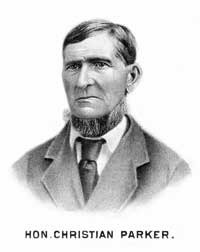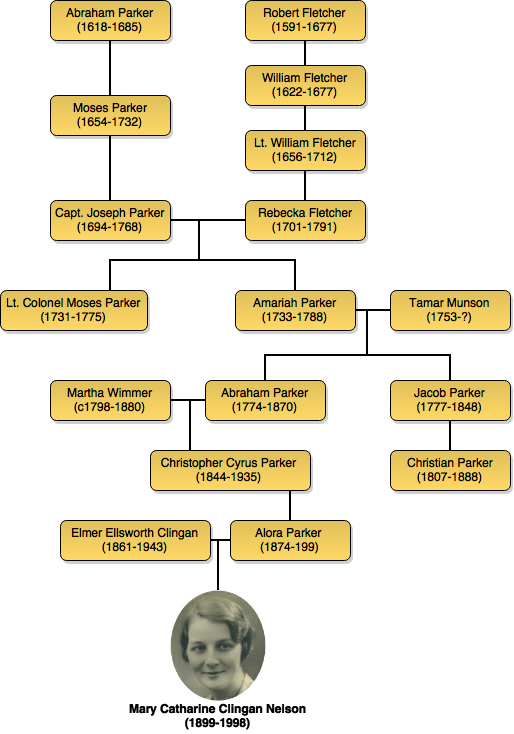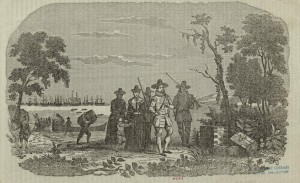1630—1780
Massachusetts and New Jersey
This chapter continues the family history of my mother, Mary Catharine Clingan Nelson. The discovery of this rather large segment of our colonial heritage came after I had thought my project was completed. Recently, on a whim, I tried one more time to find my second great grandfather Abraham Parker’s history. I discovered a wealth of recently transcribed and digitized original records and genealogical documents that were not available about five years ago when I first started to research electronic media.
The first of Mother’s New England ancestors embarked on their historic venture for a very different purpose from that of those who had come to Virginia. The early 17th century was a time of political and religious turmoil in England. There were those who were not satisfied with the limited extent of the Reformation in England and with King Charles who was putting pressure on religious dissenters. The Puritans objected the continued use of the Prayer Book, the crucifix and liturgical garments. They also disagreed about baptism and marriage.
Many of these dissenters were wealthy businessmen who were beginning to lose hope that they could accomplish the reforms they wanted in England, and they began to think that they could develop their own concept of the ideal Christian church in the New England Colony in America. John Winthrop, was a wealthy English landowner and lawyer. In 1628 a group of distinguished puritan businessmen including Winthrop formed a venture named Massachusetts Bay Company, a stock trading company initially conceived as a profit-making endeavor in the New World. He was elected governor of the colony and under his leadership the company saw an opportunity to establish a religious community there. Winthrop led a group of colonists to Massachusetts, founding a number of communities on the shores of Massachusetts Bay and the Charles River. During April 1630 eleven ships sailed to the colony and in the next decade hundreds more British families arrived in Massachusetts and New England beginning the movement which has come to be known as The Great Migration. New settlements became congregations, and fanned out from Boston.
At least twenty of these immigrant Puritan families were direct line ancestors of Mother. For this chapter in our story, we chose to trace the Parkers and Fletchers, the forebears of her great grandfather Abraham Parker who carried the name of his immigrant ancestor Abraham.
Abraham Parker and his four brothers James, Joseph, John, and Josiah made their journey to the New World early in the 1630s, possibly not together but certainly within the time of Winthrop’s Great Migration. They had all been baptized in the same parish near Chelmsford in Essex County, England—a center of puritan agitation. As did most of the Puritans of this migration they stayed first in Watertown near Boston and then gradually moved and settled other towns as land was awarded to them. From Watertown, the Parkers and Fletchers moved to Concord and from there to the town of Chelmsford, Massachusetts—named after their original home in England.
Fortunately, our research has been able to access a very early history including the Chelmsford town records that describes in fascinating detail the lives of Mother’s immigrant families who settled this area. It is in this history that Abraham Parker was noted as the first settler of Chelmsford and that all of his four brothers also lived there before settling nearby towns of Billerica and Groton.
Among these Puritan immigrants all social classes were represented from gentleman to common laborer. The requirement for becoming a “freeman” (meaning a voter) in the town was membership in the congregation, not land ownership as was the case in other colonies. Town government and church government were one and the same. Eligibility for voting in town matters required membership in the congregation. The meeting house for all government concerns was the same building used for worship. Records of town meetings were the responsibility of the pastor as were records of baptisms and church business. These records in Chelmsford reported the names of people who became members of the church and those who were eligible to vote and their participation in the affairs of the community.
Some of the people that we found in these records had been neighbors in Essex, England, many of whom, including the Fletchers, were direct ancestors of Mother’s great grandfather Abraham Parker. Robert Fletcher and his young son William had arrived in Massachusetts with the first contingent of Winthrop ships in 1630. The records also show that William Fletcher and Abraham Parker, along with with their wives, were received as members of the Chelmsford congregation on the same day. In 1718 Joseph Parker and Rebecka Fletcher, great grandchildren of these two puritan immigrants were married.
These names are mentioned frequently in the Chelmsford records along with those of other families who were also Mother’s direct line ancestors. Having taken the oath of freemen they were the judge and jury for misdemeanors and criminal behavior as well as responsible for assigning many civic duties like building roads and tracking stray cattle. Their descendants continued to live in Massachusetts for three generations, learning to deal with the Native Americans, establishing Puritan churches, managing the use of land, building roads and mills, developing judicial and economic systems and eventually participating in the American Revolution.

John Trumbull’s “The Death of General Warren at the Battle of Bunker’s Hill, June 17,1775.” According to some sources, Lieutenant Colonel Moses Parker is the man sitting the shadows at the far left of the painting. Parker died of his wounds after the battle.
Moses Parker, immigrant Abraham’s great grandson, was a lieutenant colonel of the militia that fought in the first battles of the Revolutionary War. He was present at the famed Battle of Lexington and Concord which was commemorated—somewhat idealistically—in the famous poem “Paul Revere’s Ride.” He was also in the Battle of Bunker’s Hill where he was fatally wounded and was remembered in John Trumbull’s painting of that event.
Moses’ brother Amariah also took up arms to protect the colonial settlements serving as a wagon master during the war. During this time he left Massachusetts for New Jersey, the center of military operations for the Revolution. We found information about Amariah Parker and his wife Tamar from his own will recorded in Morristown, New Jersey  in 1788 and also in a brief biography about his grandson Christian Parker who served in the Indiana state legislature. This biography, published in 1880, mentions Amariah’s service in the Revolutionary War and his marriage to a Miss Tamar Munson. (See also History of Allen Countey, Indiana).
in 1788 and also in a brief biography about his grandson Christian Parker who served in the Indiana state legislature. This biography, published in 1880, mentions Amariah’s service in the Revolutionary War and his marriage to a Miss Tamar Munson. (See also History of Allen Countey, Indiana).
The military rolls of that time show that Amariah served in the 3rd New Jersey Regiment during the historic winter at Valley Forge (1777-1778) and—what was actually the most severe winter of the war—at Morristown, New Jersey in 1780-1781. The transcription of his will, dated 1788, is difficult to interpret since no exact ages or surnames are given for any of the children. In the will Tamar has no other name, so we don’t know the true identity of her parents, but evidently Christian Parker had known her as a Munson.
 The family of Amariah and Tamar Parker included five or six children including Jacob—the grandfather of Christian Parker—and Abraham, Mother’s great grandfather. Eventually these two sons migrated to Ohio during the Indian wars. Jacob served in the army in Ohio, became acquainted with the territory and decided to settle there at the close of the war. Abraham followed and eventually married Martha Wimmer in Preble County, Ohio in 1823. Their descendents moved on to Nachusa, Illinois where Mother was born.
The family of Amariah and Tamar Parker included five or six children including Jacob—the grandfather of Christian Parker—and Abraham, Mother’s great grandfather. Eventually these two sons migrated to Ohio during the Indian wars. Jacob served in the army in Ohio, became acquainted with the territory and decided to settle there at the close of the war. Abraham followed and eventually married Martha Wimmer in Preble County, Ohio in 1823. Their descendents moved on to Nachusa, Illinois where Mother was born.
Postscript: As I was writing this narrative to complete my project of Mother’s ancestors I discovered that my high school friend of 75 years ago and I have the same 6th great grandfather, William Fletcher. His granddaughter Rebekah Fletcher married Abraham Parker’s grandson Joseph Parker! We had stayed in touch for 75 years not knowing this fascinating bit of family history. (CNE)


Very well done! I have looked at many genealogy websites but have not seen any this well organized. The links are fantastic. All of your facts are supported by reliable sources. I look forward to Puritans (Part 2). Keep up the good work.
Ever searching for my Parker history, and enjoying where it leads me, I started to work on Tamar Munson.. Imagine my delight finding my ancestor Christian Parker on these pages.(My line is Ameriah Parker,Jacob Parker, Christian Henry Parker, Samuel Christian Parker, Francis Marion Parker, Herbert Newton Parker and then myself Betty Parker Dove.) Jacob was your ancestor Abraham’s brother, and he was sent by General Anthony Wayne into what became Lanier Township to bring back a deserter. He so enjoyed the wilds of Ohio, he moved there, becoming Lanier’s first settler.. I can send you a picture of his decaying cabin left there. Jacob was bonded out to a blacksmith in New York at age 13 where he received ill treatment, and escaped. He joined the military at Fort Washington in Cincinnati, Ohio. He fought at The Battle of Fallen Timbers with The Swamp Fox, Francis Marion (My grandfather was so named because of this fact). Jacob also was a big part of the War of 1812.
He settled in Preble County, married Mary Delilah Loy. Eventually most of that group of Parkers moved to Allen County, IN.
Jacob’s sons, Jacob and Christian, buried famous character, Johnny Appleseed (John Chapman) there, making him a walnut coffin from their sawmill..(Have many articles about this.)
I knew the last place in Ohio that Appleseed visited was with Caleb Parker. Then these 2 Parkers buried him in St. Joe Township in IN. That was too much of a coincidence for the two Parker families to be strangers, yet, until now I did not know other Parkers (your Abraham) had earlier moved to Ohio. .
Would be glad to share more with you personally, if you e-mail me.
Do not know where you are located, but there is a Parker Cemetery in Ft. Wayne, IN with 700 some-odd burials, and where most of my earlier Parkers are buried.
Betty,
Thank you for these wonderful stories! There were some true pioneers in the Parker line. Mom was delighted when she read your comment, and she will be responding soon.
It was, indeed, a delight to find your Parker comment. Thanks to my son for getting Mother’s story out into the “wherever”. I have no idea about how that is done. Yes, I know very well where Ft. Wayne is. On one of our genealogy excursions which included Mother sometime in the late 1970s or early 1980s we spent a good 12 hours in the library, and I clearly remember that is when I “got hooked” into that kind of research. I don’t remember now if that particular trip had included the Preble County, Indiana library, but I have spent many hours there also trying to find the rest of the Parker family. All I had to go on was a record of the marriage for Abraham and Martha Wimmer. Yes, there were a few other Parkers but no evidence of their relationship to each other. Abraham’s family soon were residents of Kociusko County for 50 years or more. My grandfather Christopher was the youngest of all their children.
Hi…
I enjoyed reading your work on the Parker family. My wife is a descendant of Amariah Parker – Amariah Parker > Jacob Parker > Peter Parker > James D. Parker then Lydia Parker.
I have a question concerning where Amariah Parker was born. Your story and family tree seem to indicate he was born in Massachusetts. However, the article you cite for Christian Parker states that Amariah Parker came from Cornwall, England. This is also noted in the book “Valley of the Upper Maumee”. pg. 259, …
https://archive.org/stream/valleyofuppermau01madi#page/258/mode/2up.
I’ve been trying to confirm the location of Amariah Parker’s birth and would appreciate any thoughts you may have on this.
Thank you.
Mike